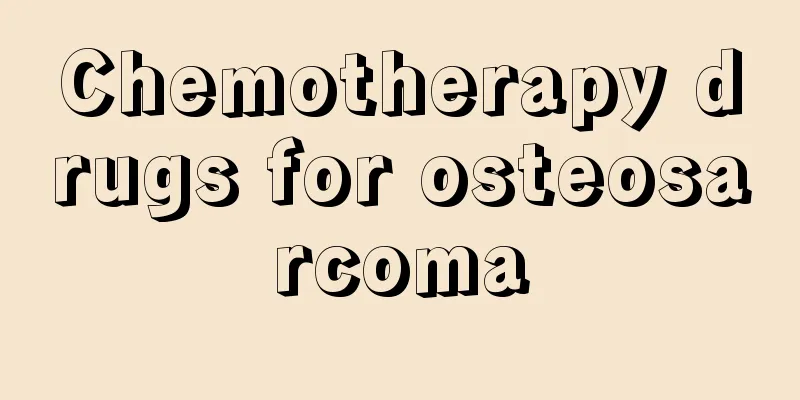Chemotherapy drugs for osteosarcoma

|
Many osteosarcoma patients are afraid of surgery and only want to be cured through other treatments. Currently, the most effective method for treating osteosarcoma is chemotherapy. Chemotherapy greatly improves the survival rate by inhibiting the occurrence of lung metastasis, and chemotherapy greatly increases the chance of limb-saving surgery without the need for amputation. However, chemotherapy requires the cooperation of drugs. Let me introduce to you the main chemotherapy drugs for osteosarcoma. Compared with traditional amputation treatment, there are two major advances: one is the comprehensive treatment based on high-dose chemotherapy; the other is the development of limb-saving surgery, which has significantly reduced the amputation rate of limbs. (1) High-dose multi-drug combination chemotherapy: After more than 30 years of extensive clinical practice, it has been proven to be a chemotherapy method with good effects. Commonly used drugs: cyclophosphamide, ifosfamide, vincristine, doxorubicin, bleomycin, etc. (2) Neoadjuvant chemotherapy: refers to chemotherapy that should be performed for at least 2 courses before surgery. The role of preoperative chemotherapy is to fully shrink and necrotize the primary tumor, shrink or eliminate the reaction area around the tumor, eliminate satellite lesions or skip lesions, help to completely remove the local tumor and strive for limb preservation; eliminate the possible tiny metastatic lesions in the lung as much as possible, and theoretically reduce the drug resistance of the tumor; based on the initial chemotherapy response, test the sensitivity of chemotherapy drugs in vivo, adjust and improve the postoperative adjuvant chemotherapy plan; start drug treatment as early as possible, which can more effectively eliminate metastatic lesions, shrink the primary lesion, postpone the time of surgery, and have enough time to prepare for surgery. Continue chemotherapy after surgery to prevent tumor recurrence and metastasis. Neoadjuvant chemotherapy with multiple drugs has achieved 5 years of no recurrence, and the survival rate has increased to 82%. At present, many neoadjuvant chemotherapy regimens include the combined use of multiple drugs, chemotherapy for more than 8 weeks, followed by tumor resection, and additional chemotherapy for 3 to 8 months after surgery. Commonly used drugs include doxorubicin and cisplatin, and increased methotrexate doses. The latest research shows that adding ifosfamide to the chemotherapy regimen can significantly increase the tumor necrosis rate and patient survival rate. Thermal chemotherapy for osteosarcoma: Thermal therapy and chemotherapy drugs can play a synergistic anti-tumor effect. Thermal therapy promotes the entry of drugs into tumor cells and promotes drug-induced apoptosis of tumor cells. Drugs commonly used in tumor thermal chemotherapy include: platinum, topoisomerase II inhibitors (etoposide and teniplatin), topoisomerase I inhibitors (camptothecin, hydroxycamptothecin and its derivatives), gemcitabine, paclitaxel, vinblastine, cyclophosphamide, mitomycin, etc. |
<<: Will osteosarcoma kill people?
>>: The most effective medicine for treating osteosarcoma
Recommend
What are the taboos of boiling water with ginger, jujube and brown sugar?
Using ginger, jujube and brown sugar to boil brow...
Pharyngitis can cause chest pain
Many areas are very dry, and people living in suc...
What is the reason for numbness in the little toe
Our feet bear our entire body weight every day as...
A can of Coke's journey through the human body. Do you want another can after reading this?
It is very enjoyable to take a sip of ice-cold Co...
Who are the susceptible groups for cervical cancer
Cervical cancer is one of the common malignant tu...
What are the conventional treatments for fibroids?
Fibroids generally grow slowly, most of them are ...
How to care for patients with cerebral hemorrhage?
Cerebral hemorrhage, commonly known as cerebral h...
Why does water ooze out after a burn
In our daily life, we often encounter burns. Seve...
First aid for children's ear pain
Children are very sensitive to pain issues. They ...
Effects of red coix seed and gorgon fruit tea and suitable groups
Red coix seed and Euryale gorgon fruit tea is a h...
What are the examination methods for glioma
Gliomas are a type of brain tumor with very speci...
What are the effects and functions of thorn energy oil
Thorn energy oil is a kind of essential oil and a...
What are the adverse reactions to drinking MSG with water?
MSG can make dishes more flavorful and increase a...
What harm does teratoma do to women
Ovarian teratoma needs to be treated in time afte...
Sacral chordoma symptoms
Sacral chordoma is a type of tumor that occurs fr...









